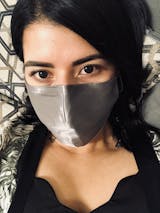Acne is a common skin issue that affects many adults all across the world. And the worst part is that it can be really confusing to know how to deal with acne through natural treatments. There are so many different products and treatments recommended for acne sufferers. But how do you really know which are the most effective ingredients for acne-prone skin?
In this article we go through the best natural ingredients for acne-prone skin, and how to use them easily at home.
What Are The Best Natural Ingredients For Acne?
These natural ingredients help clear acne, and you can use them easily at home. Try incorporating some of these products and ingredients into your daily skin-care routine to see the difference in your skin health.
Apple Cider Vinegar
Apple cider vinegar is a powerful natural ingredient that is great for acne. But it is also great for the skin in general. It helps to soothe inflamed skin and it is a mild acid. So it helps to restore the pH balance of the skin which is slightly acidic.
Apple cider vinegar is good for acne because it contains acetic acid which is great for reducing bacteria growth. And the antimicrobial properties of apple cider vinegar help it to prevent the spread of acne-causing bacteria, which makes it a great choice for natural acne treatment.
How To Use: Dilute apple cider vinegar with water and use it as an astringent toner before your moisturizer. Or you can directly apply apple cider vinegar onto a pimple in order to clear it up quickly.
Glycolic Acid
Glycolic acid is great for the skin in general as it's high in antioxidants and is anti-bacterial. Glycolic acid helps to improve collagen production and wound healing. Making it perfect for acne-prone skin.
If you’re trying to reduce acne scarring and prevent further acne - then a glycolic acid peel is for you. Glycolic acid peels remove dead skin cells, brighten the complexion, and smoothen skin tone. Glycolic acid can deeply penetrate into the skin so it helps to unclog pores and smoothen out skin texture which minimizes the risk of further breakouts.
How To Use: Use a specialized glycolic acid peel once a week or as directed.
Editor’s Choice: M.S Skincare Enlighten | Retexturizing Glycolic Treatment
Green Tea
Green tea can help to reduce acne because it contains polyphenols. Polyphenols help to fight bacteria and the damage caused by free radicals. The anti-inflammatory properties of green tea also help reduce skin irritation and redness.
How To Use: You can use green tea as a natural ingredient or within a product formulation. Make yourself a green tea natural facial toner by preparing the green tea and letting it cool down. Keep the green tea toner refrigerated and spritz the skin prior to using your moisturizer.
Jojoba Oil
Jojoba oil is non-comedogenic and mimics the skin’s natural oil, which makes it great for acne-prone skin. You can use oil on your skin as long as it has a low comedogenic rating because it will be less likely to cause further breakouts.
Oil can in fact be really good for acne-prone skin as it helps to balance the skin’s natural oil by adding much need hydration. This prevents the skin from overproducing oil unnecessarily to hydrate itself. The healing, antimicrobial, and anti-inflammatory properties of jojoba oil make it a great option to help heal acne.
How To Use:
You can use jojoba oil instead of moisturizer or serum without it causing further spots, inflammation, or acne. Or you can use it as a makeup remover and facial cleanser. Simply massage the oil into the skin and then remove dirt and grime with a cotton pad or reusable cotton cloth. After all traces of makeup dirt and grime are gone rinse your face with warm water and pat the skin dry. Follow up with toner and moisturizer.
Editor’s Choice: Honua Ritual | Olena Beauty Oil
Salicylic Acid
Salicylic acid is a powerful natural exfoliant that can help to remove dead skin cells, decrease redness, reduce inflammation and swelling. Salicylic acid helps to remove the risk of further acne, speeds wound healing, and reduces acne scarring. Using an acid peel once a week helps to unclog blocked pores and sebaceous glands. And using an acid peel weekly helps to break down the sebum that creates acne, whilst also smoothing skin tone, brightening the skin complexion, and improving skin texture.
How To Use: Use a specialized salicylic acid peel once a week or as directed.
Tea Tree Oil
Tea tree oil is an effective treatment for acne because it helps to reduce swelling and inflammation. Tea tree possesses strong antimicrobial properties and is known to prevent the spread of bacteria. is knBut it’s also an essential oil which means that it needs to be diluted prior to use.
How To Use: Combine tea tree oil with a suitable carrier oil to dilute its strength and reduce the concentration. Once diluted you can apply it straight to the affected area using a cotton pad or reusable facial cloth. This will help to reduce swelling, inflammation, and irritation.
Willow Bark Extract
Willow bark extract contains salicin which is what salicylic acid is made from. Willow bark extract is anti-bacterial and anti-inflammatory and it helps to clear the pores, reduce inflammation, and alleviate irritation.
Editor’s Choice: M.S Skincare Illume | Radiance Enhancing Moisturizer
Witch Hazel
Witch hazel is rich in antioxidant properties which helps to protect the skin from free radical damage. And it also acts as a protective barrier for your skin cells. Witch hazel contains active tannins which help to dry out blemishes like acne Are Natural Products Better For Acne?
Editor’s Choice: Honua Ritual Pa’akai Cleansing Cream
Why Is My Acne Not Going Away?
There can be multiple different reasons that you are suffering from acne, so it is important to check a variety of different causes. Diet, sleep, stress, health, and overall wellness play a huge role in skin health. So make sure that you are living in the best way that you possibly can. It can help to keep a trigger diary, so you can observe if there are any noticeable changes at certain periods of the month.
Conclusion
Try not to chop and change between different products and ingredients. It is best to allow a product to settle on the skin and fully work in the skin before you judge it. Plus it can cause way more inflammation to the skin to keep switching products.
Now you have the blueprint of ingredients that help acne, and you can also find them in these ready-made products too for ease. Start your journey with healthy, happy and glowing skin today.
Carmen Lee is a certified yoga teacher, childbirth doula, and wellness coach. She educates on womb wellness, sacred wisdom, and ancestral-connected living. You’ll find her passionately advocating radical self-care and transformational self-empowerment through sustainable beauty and self-love rituals.
Some of the products promoted in our blog are from our online store. Many others are brands we have researched and found to be great examples of sustainable, ethical, and innovative brands in their field, and we don't make any profit from mentioning them in our blog. #CollaborationOverCompetition










